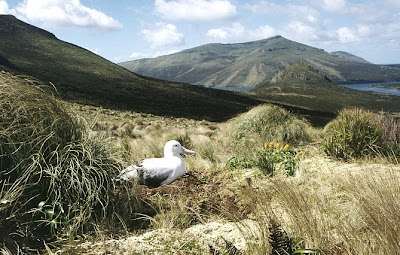Sub-Antarctic Islands off New Zealalnd & Australia 1999 No. 2
We continue with our trip


Spotted Shags Phalacrocorax punctatus with a Kelp Gull standing on a quay at Bluff, South Island. The Spotted Shag is endemic to New Zealand including some off-shore islands. and we saw 8 at Bluff and 2 at Wellington. During our trip we identified ten species of Shags.

A mixed feeding flock of Storm Petrels, Prions etc on our approach to the Chathams.




Fur Seals were recorded from a number of Islands,
including the Bounties and Chathams.

Southern Royal Albatross Diomedea epomophora .Breeds on Campbell Island (7,500 pairs) and the Auckland Island Group (60 pairs). We saw this species on nests on both Enderby Island and Campbell Island, and in total we recorded it on twelve dates at sea.which included 200 on the sea heading towards Macquarie Island.
Two species of Royal Albatrosses, the Southern and the Northern. Identifaction is fairly straight forward. with the Northern appearing slightly smaller with its upper-wings virtually solid black where as in the Southern which has some white mixed into the black on the upper-wings and this increases with age, as shown in the picture above. The Northern also has a much thicker black line extending from the black tip of the underwing along the edge, whereas in Southern this underwing line is much thinner. The Wandering Albatross group is fairly similar in size but the adults shows a black tail band which on both Northern and Southern the adult tails are white.

Perhaps this Southern Royal had this nest site for the view.

Southern Royal Albatross on Campbell Island








Southern Royal Albatross breeding on Campbell Island, and they ignored us.


Again showing the extensive white on the upper-wings.

Showing the narrow black line on the trailing edge of the underwing.


Southern Royal with 2 Campbell Albatrosses off Campbell Island.

Southern Royals squabbling for chum

On one part of the island we found several young adults in a small group.

This one is testing its wings before leaving
.

Southern Giant Petrel Macronectes giganteus after feeding on a dead whale. We only recorded them on five dates with a daily max. of sixty, which included several white phased birds. Southern has a pale tip to the bill, whereas the Northern has usually a dark tip.


Dark phase Southern Giant Petrels

White phase of Southern Giant Petrel with a Northern Giant Petrel, off Macquarie Island

Several white phase Southern Giant Petrels were seen in the Southern part of our trip.


Sooty Shearwaters Ardenna grisea Very large numbers breed on the Snares. with an estimate of seven million breeding pairs.



Sooty Shearwaters with Cape Petrels off the Snares
Soft-plumaged Petrel Pterodroma mollis Recorded on seven days with a daily max. of 15. Unfortunately, they often appear during the evening when the light was beginning to go and they very rarely came close to our vessel. The collar can be variable often giving the appearance of a darkish throat. One of our highlights of the trip.




Snowy Wandering Albatross Diomedea exclans Just two Snowy types seen the first enroute to Macquarie Island and the second bird came into chumming and gave good views both on the sea and in flight between Chatham's and Wellington. There was some debate on this individual, as some Snowies
show more extensive white on the upper-wings. To my eye, the pale pink bill and softer appearance around the head, whiter looking when sat on the sea, all looked good for a Snowy.










